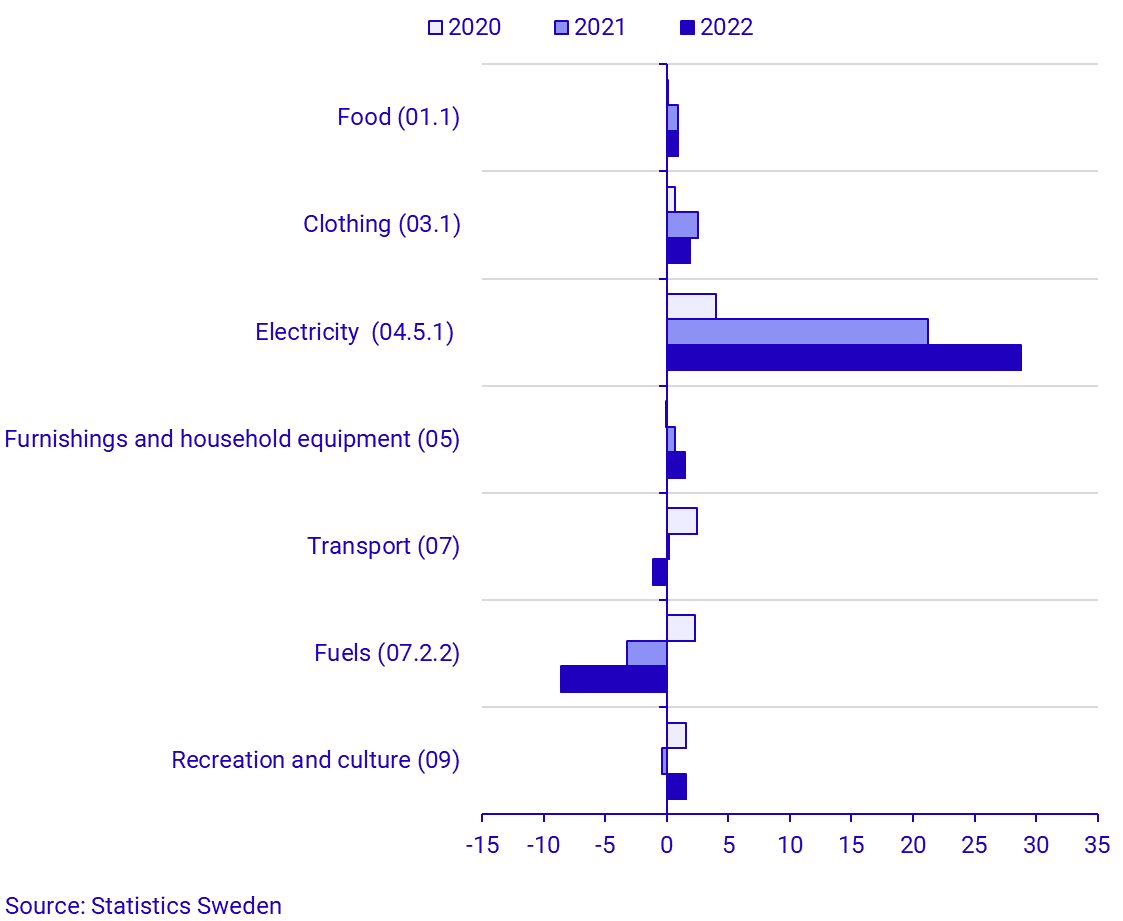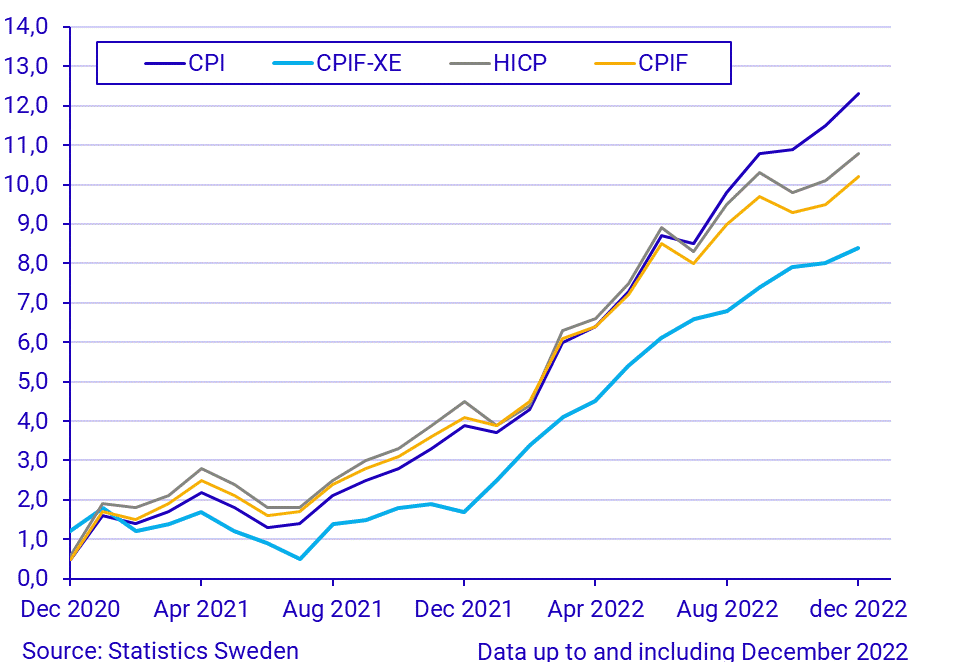Consumer Price Index (CPI), December 2022
Inflation rate according to CPIF was 10.2 percent in December 2022
Statistical news from Statistics Sweden 2023-01-13 8.00
The CPIF (Consumer Price Index with fixed interest rate) 12-month inflation rate was 10.2 percent in December 2022, up from 9.5 percent in November. On a monthly basis, the inflation rate according to the CPIF increased by 1.9 percent from November to December.
“Electricity prices continued to increase in December”, says Mikael Nordin, statistician at Statistics Sweden
In brief
| Index Numbers |
Monthly changes, percent |
Annual changes, percent |
|
|---|---|---|---|
| CPI (1980=100) | 395.96 | 2.1 | 12.3 |
| CPIF (1987=100) | 254.81 | 1.9 | 10.2 |
| CPIF-XE (1987=100) | 231.83 | 0.8 | 8.4 |
- Increased interest expenses contributed with 2.3 percentage points to the inflation rate according to CPI which amounted to 12.3 percent
- Electricity prices rose by 28.8 percent in December compared to the previous month
- Food prices have increased with 18.6 percent during the year
- The inflation rate according to CPIF excluding energy increased from 8.0 percent in November to 8.4 percent in December
“The inflation rate according to the CPI was higher than CPIF because of the increased interest rates of mortgages. This effect is eliminated from CPIF. Otherwise, the two measures are similar”, says Caroline Neander, statistician at Statistics Sweden.
Continued increase in electricity prices
The CPIF increased by 1.9 percent from November to December. In the corresponding period a year ago, the CPIF rose by 1.3 percent.
The monthly rate of change was mainly affected by electricity prices which rose with almost 29 percent. Food prices have increased thirteen consecutive months and the price rose with 0.9 percent in December. Clothing noted a price increase of about 2 percent which is normal for the season. Price increases were also noted within recreation and culture as well as furnishings and household equipment.
The upward contributions to the monthly change were mainly offset by decreasing prices for fuel which contributed to the falling prices within transportation.
The table below shows changes on a monthly basis and contributions to the CPIF based on the goods and services that had the greatest impact on the CPIF in December 2022. The results are presented by COICOP category. COICOP refers to the United Nations classification of household consumption expenditure.
| Category (Coicop) | Monthly changes, percent |
Contribution to CPIF Monthly change, percentage points |
|---|---|---|
| Food (01.1) | 0.9 | 0.1 |
| Clothing (03.1) | 1.9 | 0.1 |
| Electricity (04.5.1) | 28.8 | 1.4 |
| Furnishings and household equipment (05) | 1.5 | 0.1 |
| Transport (07) | ‑1.1 | ‑0.2 |
| Fuels (07.2.2) | ‑8.6 | ‑0.3 |
| Recreation and culture (09) | 1.5 | 0.2 |

Seasonal patterns and temporary price changes
Price changes on goods and services may be seasonal or temporary. The figure above shows the monthly changes this year and in the two preceding years for those goods and services which had the largest impact on the CPIF monthly change.
Food prices have increased in December the last three years. The price increase in December 2021 and 2022 was 0.9 percent, which is slightly larger compared to the price increase of 0.1 percent in December 2020.
Clothing prices rose in December which is normal for the season. The last three years, prices have increased between 0.6 and 2.6 percent. Electricity prices have, like food and clothing, also increased in December the last three years.
Prices within furnishings and household equipment rose in December 2022 and 2021. In December 2020 these products noted a marginal price decrease of -0.1 percent.
Transport prices fell in December 2022 but have risen in the corresponding month in 2021 and 2022. Fuel prices, which is a subset of transport, declined in December 2022 and 2021, but rose in December 2020.
The monthly rate of change within recreation and culture for December the last three years have varied. Prices increased in 2022 and 2020, but fell in 2021.
Increasing inflation rate in December
The inflation rate according to CPIF, that is, the change in CPIF from the same month of the previous year, was 10.2 percent in December 2022. This is an increase from November when the inflation rate was 9.5 percent.
The inflation rate according to the CPI, which unlike CPIF is affected by changes in interest rates, was 12.3 percent in December. This is an increase compared to November when it was 11.5 percent.
The inflation rate was impacted by a broad price increase within food, where the main contributions came from milk, cheese and eggs, meat as well as bread and cereals. Electricity prices rose with about 45 percent during the last year, which continue to contribute to the inflation rate. Prices also rose for fuel and cars, which contributed to the increased transport prices.
In addition to the products mentioned above, the inflation rate was impacted by price increases for many goods and services. For instance, price increases have been noted within furnishings and household equipment, restaurant visits, recreation and culture as well as miscellaneous goods and services.
The inflation rate calculated excluding energy products (CPIF-XE) was 8.4 percent in December, which is an increase compared to November when it was 8.0 percent.
| Category (Coicop) | Yearly change, percent |
Contribution yearly change CPIF percentage points |
|---|---|---|
| Food (01.1) | 18.6 | 2.3 |
| Electricity (04.5.1) | 45.3 | 1.9 |
| Furnishings and household goods (05) | 16.3 | 1.1 |
| Transport (07) | 8.8 | 1.3 |
| Fuels (07.2.2) | 16.7 | 0.5 |
| Recreation and culture (09) | 6.3 | 0.8 |
| Restaurants (11.1) | 9.2 | 0.5 |
| Miscellaneous goods and services (12) | 5.7 | 0.4 |
CPI and CPIF, two different measures of inflation
As from the publication of CPI regarding January 2023 (publication date 2023-02-20), the statistical news will shift the main focus from CPIF to CPI. This will affect the title and the introduction, but also the tables and diagrams that are presented. CPIF will continue to be presented in the statistical news. The reason behind the change in the statistical news is an increased interest in the general price trend in Sweden as shown by the CPI.
CPI and CPIF are two different measures of inflation that Statistics Sweden calculates. The most common measure of inflation in Sweden is the change in the Consumer Price Index (CPI), but it is the CPIF that is the measure that the Riksbank uses in its inflation target. The CPIF includes the same goods and services as the CPI. The difference between CPI and CPIF is that in CPIF, interest rates for households’ mortgages are kept constant. This means that the effect of changes in interest rates for households’ mortgages is only captured in the CPI and not in the CPIF.
Changes in 2023
Major changes in the production of the Consumer Price Index will be introduced from 2023. For further information, please see:
Changes in the CPI as from 2023 (pdf)
Different measures of inflation
Statistics Sweden calculates different inflation measures for different purposes. The CPIF is the Riksbank’s target variable, while the CPI is the measure used for purposes of compensation.

Definitions and explanations
The CPIF shows the same price trend as the CPI, but without the direct effects of a changed monetary policy. The CPIF is the Riksbank’s target variable for the inflation target.
The CPIF excluding energy (CPIF-XE) and the CPIF with constant tax (CPIF-CT) are two other measures of inflation produced by Statistics Sweden on behalf of the Riksbank. In the CPIF-XE, energy products are excluded from the CPIF, while in the CPIF-CT the taxes and subsidies associated with the products in the CPIF are kept constant.
The HICP (Harmonised Index of Consumer Prices) is produced by all EU Member States. This measure has a somewhat smaller coverage than the CPI and the CPIF, mainly because parts of households’ housing costs are omitted.
Next publishing will be
2023-02-20 at 8:00.
Statistical Database
More information is available in the Statistical Database
Feel free to use the facts from this statistical news but remember to state Source: Statistics Sweden.
